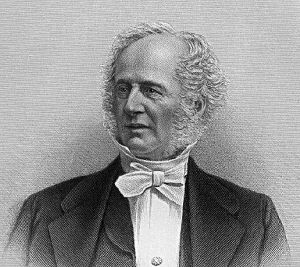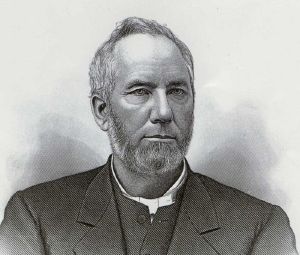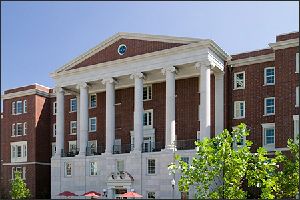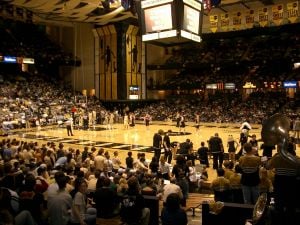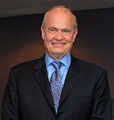Vanderbilt University
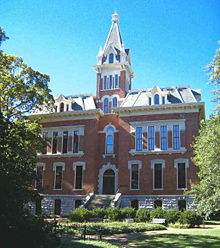
| |
| Established | 1873 |
|---|---|
| Type | Private |
| Location | Nashville, TN U.S. |
| Website | www.vanderbilt.edu |
Vanderbilt University is a private, nonsectarian, coeducational research university in Nashville, Tennessee, United States. Founded in 1873, the university is named for shipping and rail magnate "Commodore" Cornelius Vanderbilt, who provided Vanderbilt its initial $1 million endowment in the hopes of making a contribution to the struggling society of the Post-Civil War South.
Today, Vanderbilt comprises four undergraduate and six graduate schools, and enrolls a large number of students from all 50 U.S. states and many foreign countries. Beyond its academic programs, the university is known for its research programs and has many institutes.
Mission and Reputation
Vanderbilt states its mission as centering around "scholary research, informed and creative teaching, and service to the community and society at large."[1] The school's web site goes on to state that its dedication to "intellectual freedom that supports open inquiry" and "equality, compassion, and excellence in all endeavors" are the means to which it actively pursues its Mission.[2]
Vanderbilt University has a long held reputation for excellence, both in its teaching and research. In its 2009 edition, U.S. News & World Report placed Vanderbilt at 18th, tied with the University of Notre Dame and Emory University, in its ranking of national universities.[3] In the same publication's 2008 graduate program rankings, Peabody College was listed at 2nd among schools of education, the Vanderbilt Law School was listed at 15th, the School of Medicine was listed at 16th among research-oriented medical schools, the School of Nursing was listed at 19th, and the Owen Graduate School of Management was listed at 34th among business schools.[4]
History
The University is named after Cornelius Vanderbilt, a wealthy, northern industrialist who made the initial donotation of $500,000 to the Methodist Episcopal Church, Southso as to "contribute to strengthening the ties which should exist between all sections of our common country."[5] The donation was made to Bishop Holland McTyerie who was related to Vanderbilt through marriage and visiting his estate in . Vanderbilt, had been considering philanthropic causes as he was at an advanced age.[6] After successfully convincing Vanderbilt of the cause for a central Southern University, McTyerie returned to the the governing body of the Methodist Episcopal Church with enough money to start the university.
In the fall of 1875, about 200 students enrolled at Vanderbilt; the university was dedicated in October of that year.
For the first 40 years, the Board of Trust (and therefore the university itself) was under the control of the General Conference (the governing body) of the Methodist Episcopal Church, South. However, tensions began rising between the university administration and the Conference over the future of the school, particularly over the methods by which members of the Vanderbilt Board of Trust would be chosen and the extent to which non-Methodists could teach at the school.[7]
Starting in the early years of the 20th century, a power struggle between the Bishops and the non-clergy members of the Board began, culuminating in a vote to limit the power of the Bishops in the administration of the school. The Methodist Church took the issue to court and won at the local level; however, on March 21, 1914, the Tennessee Supreme Court ruled that the Commodore, and not the Methodist Church, was the university's founder and that the board could therefore seat whomever it wished.[8] The General Conference in 1914 voted 151 to 140 to sever its ties with Vanderbilt; it also voted to establish a new university, Southern Methodist University, and to greatly expand Emory University.[9]
Vanderbilt enjoyed early intellectual influence during the 1920s and 1930s when it hosted two partly overlapping groups of scholars who had a large impact on American thought and letters: the Fugitives and the Agrarians.[10] During the same period, Ernest William Goodpasture and his colleagues in the School of Medicine invented methods for cultivating viruses and rickettsiae in fertilized chicken eggs. This work made possible the production of vaccines against chicken pox, smallpox, yellow fever, typhus, Rocky mountain spotted fever and other diseases caused by agents that only propagate in living cells.[11] These innovations helped to propel Vanderbilt's reputation as a research institution on par with some of the older and more prestigious U.S. schools at the time.
In the late 1950s, the Vanderbilt Divinity School became something of a hotbed of the emerging civil rights movement. A prominent leader and colleauge of Dr. Martin Luther King, Jr., James Lawson, was enrolled at the university's Divinity School as well as staging non-violent protests, which resulted in his expulsion from the school in the early 1960s. Much later, in 2005, he was named a Distinguished Alumnus for his achievements and re-hired as a Distinguished University Professor for the 2006–07 academic year.[12] Some years later, the university drew national attention once again, only this time it was for an act of inclusion. In 1966, the university recruited the first African American athlete in the Southeastern Conference, Perry Wallace.[13] Wallace, from Nashville, played varsity basketball for Vanderbilt from 1967-1970, and faced considerable opposition from segregationists when playing at other SEC venues. Today a statue of him in front of Buttrick Hall memorializes his efforts.
From the mid 20th century onward, Vanderbilt University expanded, with the addition of new colleges, such as the Owen Graduate School of Management and the acquistion of Peabody College. Resarch and facilities also greatly improved and were continously upgraded as Vanderbilt's reputation for exellence in the are of research became more widely recognized.
Facilities
The Vanderbilt campus is located approximately 1.5 miles (2.4 km) southwest of downtown in the West End neighborhood of midtown Nashville. It has an area of 330 acres (1.3 km²), though this figure includes large tracts of sparsely used land in the southwest part of the main campus, as well as the Medical Center. The historical core of campus encompasses approximately 30 acres (0.1 km²).
The oldest part of the Vanderbilt campus is known for its abundance of trees and green space, which stand in contrast to the surrounding cityscape of urban Nashville. The campus was designated as a national arboretum in 1988 by the Association of Botanical Gardens and Arboreta.[14]. Every tree indigenous to the state of Tennessee can be found on Vanderbilt’s 330-acre campus. The oak tree between Garland Hall and Rand Hall is known as the Bicentennial Oak, as it predates the American Revolution.[15]
In the northeast corner of the campus is the original campus, which has many historic buildings that date back to the establishment of the university in the late 19th century. To the south are the more modern additions to the campus, including many of the science and medical facilities. Directly across from the Medical Center sits the campus of the Peabody College of Education and Human Development. Due to their separate histories until the merger, the Peabody campus was configured in a radically different style than the original Vanderbilt campus. Whereas the latter has an unplanned organic design with buildings scattered throughout, Peabody campus was planned as a geometric design, similar to the Jeffersonian style of the University of Virginia. The campus is home not only to Peabody College but also to The Commons, where all freshmen live together as part of the College Halls plan.
The Jean and Alexander Heard Library is the main library on campus. Originally established in 1873, the library suffered a fire that destroyed most of the collection.[16] It took many years to build the library's collection to where it stands today at approximately 2 million. The Library also houses several unqiue collections, such as the Television News Archive, the University Memorabilia Room, Photograph Archives and a selection of speciality manuscripts.
There are also seven library branches located on campus, specificed for certain academic areas: Peabody Library, Law Library, Divinty Library, Science and Engineering Library, Biomedical Library, Music Library and Mangament Library.
Vanderbilt University has several atheltic and health related facilities. College basketball teams play in the the Memorial Gymnasium, which has a seating capacity of aproximately 14, 316.[17] Vanderbilt Stadium is where football is played, a stadium built in 1981 with a seating capacity of 39,790.[18] Other facilities include Hawkins Field for baseball, the Vanderbilt Track, a soccer and lacrosse field, the Brownlee O. Currey Jr. Tennis Center, and the John Rich Complex for athletic training. The Vanderbilt Legends Club of Tennessee is a 36 hole golf course that is located off campus. The university also has several excercise and health centers for students, most of which are located in the Student Recreation Center.
Programs
Vanderbilt University offers all levels of 4 year or more degrees: Bachelor's (undergraduate), Master's (graduate), and Doctorate/PhD (post-graduate). The College of Arts and Sciences offers both classic and more modern variants of the Liberal Arts and Sciences majors, including African American and Diaspora Studies, Ancient Ancient Mediterranean Studies Studies, Anthropology, Art Studio, Biological Sciences, Chemistry, Ecology, Evolution, and Organismal Biology, Economics, English, Film Studies, Mathematics, Neuroscience, Psychology and Women’s and Gender Studies.
The Blair School of Music offers four undergraduate degrees: Musical performance, composition/theory, musical arts and musical education. The school of engineering offers several variety of undergraduate degrees, including Biomedical Engineering, Chemical Engineering, Civil Engineering, Computer Engineering, Electrical Engineering, Mechanical Engineering. The school offers graduate and post-graduate degrees in general engineering science.
The Divinty School offers Master's and Doctorate degrees in Theological Studies, Ethics and Society, Hebrew Bible and Ancient Israel, Historical Studies, History and Critical, Theories of Religion, Homiletics and Liturgics, Jewish Studies (M.A.), New Testament and Early Christianity and Religion, Psychology, and Culture. The Law school offers the Master's level Jurispuridence degree as well as a PhD in Law and Economics. The Owen Graduate School of Management offers the general Master of Business Administration, Finance and Accountancy. The School of Medicine offers a Medical degree and health-related, but non medical, degrees such as Biomedical Informatics, Chemical & Physical Biology Program, Hearing and Speech Sciences and Interdisciplinary Graduate Program in the Biological Sciences. The School fo Nursing offers both a Master's and PhD in Nursing. sing offers both a Master's and PhD in Nursing.
Colleges and Institutes
Vanderbilt University has 4 undergraduate schools:
- College of Arts and Science
- Blair School of Music
- School of Engineering
- Peabody College of Education and Human Development
The University also has six graduate and continuing education colleges:
- Divinity School
- Graduate School
- Law School
- School of Medicine
- Owen Graduate School of Management
- School of Nursing
In addition, the University has over 50 separate Research Centers and Facilities, which include:
- Addiction Research Center
- African American Mental Health Research Scientist Consortium
- Bandy, W.T. Center for Baudelaire and Modern French Studies
- Center for Biomedical Ethics and Society
- Brain Institute
- Cal Turner Program for Moral Leadership for the Professions
- Carpenter Program in Religion, Gender and Sexuality
- Cognitive Robotics Laboratory
- Family-School Partnership Lab
- First Amendment Center
- Vanderbilt University Institute of Imaging Science
- Robotics Lab
- Center for Latin American Studies
- Center for Molecular Neuroscience
- Robert Penn Warren Center for the Humanities
- Vanderbilt-Meharry Center for AIDS Research
The Vanderbilt University Medical Center is a vital component of the university and is the only Level I Trauma Center in Middle Tennessee.[19] VUMC comprises the following units:
- Vanderbilt University Hospital
- Monroe Carell, Jr., Children's Hospital at Vanderbilt
- Vanderbilt-Ingram Cancer Center
- The Vanderbilt Clinic
- Vanderbilt Bill Wilkerson Center
- Vanderbilt Stallworth Rehabilitation Hospital
- Vanderbilt Psychiatric Hospital
- Eskind Biomedical Library
- Vanderbilt Sports Medicine
- Dayani Human Performance Center
- Vanderbilt Page Campbell Heart Institute
Student Life
The university recognizes nearly 400 student organizations, ranging from academic major societies and honoraries to recreational sports clubs, the oldest of which is the Vanderbilt Sailing Club. There are also more than 30 service organizations on campus, giving students the opportunity to perform community service across the country and around the world, including the Vanderbilt-founded Alternative Spring Break.
Despite the lack of an organized journalism curriculum, no less than ten editorially-independent media outlets are produced and controlled by students. In addition, a sportswriting scholarship, named for Vanderbilt alumni Fred Russell and Grantland Rice, is awarded each year to an entering Vanderbilt freshman who intends to pursue a career in sportswriting. Vanderbilt Student Communications, Inc., (VSC) owns eight print publications, a broadcast radio station, and a closed-circuit television station. One publication, The Vanderbilt Hustler, was established in 1888 and is the oldest continuously published newspaper in Nashville (the newspaper's name references another nickname for the Commodore based on his cutthroat business practices, i.e., that he "hustled" people out of their money). The on-campus radio station, WRVU, represents the student body by playing a range of music from bluegrass to choral, with a focus on non-mainstream music,[20] while the campus television station, Vanderbilt Television (VTV), showcases student-produced films, skits, and news and entertainment-based shows.
VSC was formed as a not-for-profit corporation in 1967 to insulate the university from potential liability and to maintain journalistic independence after a series of controversial articles published by The Hustler. During the 1970s, VSC funded a visiting journalist position to provide advice and counsel to its various operating units. Initially, the directors of VSC included a faculty chairman of the board of directors, several student directors, and an outside journalist director. Among the earlier journalist directors was John Seigenthaler, the then-president, publisher, and editor of The Tennessean, who also played an instrumental role in the creation of USA Today.
Additional student publications include those published by the Vanderbilt University Law School, which publishes three law reviews; the flagship journal is the Vanderbilt Law Review.
Greeks are an active part of the social scene on and off campus, and the university is home to 21 fraternities and 14 sororities. As of 2006–2007, 35% of men were members of fraternities and 49% of women were members of sororities, or 42% of the total undergraduate population.[21]
Traditions
Since the first classes began at Vanderbilt, the Honor System has served to strengthen the academic integrity of the university. Its principles were outlined in a famous quote by long-time Dean of Students Madison Sarratt:[22]
Today I am going to give you two examinations, one in trigonometry and one in honesty. I hope you will pass them both, but if you must fail one, let it be trigonometry, for there are many good men in this world today who cannot pass an examination in trigonometry, but there are no good men in the world who cannot pass an examination in honesty.
As a part of their first act together as a class, each Vanderbilt class meets together at the Honor Code Signing Ceremony, where every member of the class pledges their honor and signs the code. The signature pages are then hung in Sarratt Student Center. The ceremony is one of only two occasions where a class will be congregated in a single place at the same time (the other being Commencement).
The Undergraduate Honor Council was formed to help enforce and protect the tradition of the Honor Code. Today, the Honor Council serves two simultaneous aims: to enforce and protect the Honor Code and to inform members of the Vanderbilt community about the Honor System.
[
Myths
Vanderbilt's long history has given birth to several myths and urban legends. Some of the more well known:[23]
- The administration at Vanderbilt has canceled classes only twice, once because of a loose bull on campus.
- Fact: Vanderbilt has canceled classes many times over its history, but not because of a loose bull.
- There is no bell at the top of Kirkland Hall, just a stereo system that imitates chimes.
- Fact: After Kirkland Hall burned in 1905, Nashville schoolchildren collected money for a new 2,000-pound bell, which still chimes on the hour from Kirkland Tower.
- The teacher in Dead Poets Society is based on Vanderbilt professor John Lachs.
- Fact: The film's screenplay was written by Tom Schulman, who is a Vanderbilt alumnus, but he based the story on his experiences at Montgomery Bell Academy, a Nashville area prep school.
Athletics
Vanderbilt is a charter member of the Southeastern Conference and is the conference's only private school. With fewer than 6,600 undergraduates, the school is also the smallest in the conference; the SEC's next-smallest school, the University of Mississippi, has nearly twice as many undergraduate students. Vanderbilt therefore fields fewer teams than any of its rivals—only 16—and sometimes lacks the national prominence enjoyed by schools such as the University of Florida or the University of Kentucky. Additionally, the school is a member of the American Lacrosse Conference for women's lacrosse, as the SEC does not sponsor that sport. Conversely, Vanderbilt is the only league school not to field teams in softball and volleyball, but has discussed adding either or both sports in the future.[24]
Men's and women's tennis and men's and women's basketball are traditionally Vanderbilt's strongest sports, with the more recently founded women's lacrosse and bowling programs as well as the long-standing men's baseball program experiencing moderate national success. After enjoying success in the first half of the 20th century, the football program has struggled in more recent times.
Athletics restructuring
In September 2003, Vanderbilt earned national attention when it announced that it was eliminating its athletic department. Then-Chancellor Gee called Vanderbilt's varsity athletes "isolated," and insisted that student-athletes would perform better if they were integrated into the rest of the student body. So rather than administer athletics separately from student life, Gee folded the university's varsity teams into the Office of Student Life, the same group that oversees all student organizations. The university is unique in Division I in this regard.[25] Despite fears that Vanderbilt would lose coaches and recruits or would be forced out of the SEC, the university has experienced considerable success since the change; 2006–07 was one of the best in the school's athletic history. At one point, seven of Vanderbilt's 16 teams were concurrently ranked in the Top 25 of their respective sports.[26] Women's bowling won the NCAA championship, bringing the university its first and only team championship since the advent of the NCAA.[27] The baseball team qualified for the NCAA Super Regionals in 2004, had the nation's top recruiting class in 2005 according to Baseball America,[28] made the NCAA field again in 2006, and won the 2007 SEC regular-season and tournament championships. Vanderbilt was ranked first in most polls for a large portion of the 2007 season, and the team secured the top seed in the 2007 NCAA tournament.[29]
Mascot
Vanderbilt's intercollegiate athletics teams are nicknamed the Commodores, in honor of the nickname given to Cornelius Vanderbilt, who made his fortune in shipping. Students and alumni refer to Vanderbilt athletic teams as the "Dores" and use the cheer "Go Dores!"
The term commodore was used by the Navy during the mid- to late-nineteenth century. A commodore was the commanding officer of a task force of ships, and therefore higher in rank than a captain but lower in rank than an admiral. The closest parallel to this now-defunct rank is rear admiral lower-half. Since the term was used most during the 19th century, Vanderbilt's mascot is usually portrayed as a naval officer named "Mr. C" from the late 1800s, complete with mutton chops, cutlass, and uniform.
Notable Alumni and Faculty
- John D. Arnold, founder of Centaurus Energy
- Rosanne Cash, singer and songwriter
- William Prentice Cooper - former Governor of Tennessee and Ambassador to Peru
- Max Ludwig Henning Delbrück - biophysicist and Nobel laureate
- Michael L. Gernhardt - NASA Astronaut
- Al Gore, 45th Vice President of the United States, former U.S. Senator, former U.S. Representative, environmental activist
- Amy Grant - Contemporary Christian music artist
- Marci Hamilton- lawyer, won Boerne v. Flores (1997), Constitutional law scholar
- James Clark McReynolds - Associate Justice of the United States Supreme Court
- James Patterson - bestselling contemporary writer of thrillers
- H. Ross Perot, Jr. - Chairman of Perot Systems, real estate investor
- Wendell Rawls, Jr.- journalist, Pulitzer Prize winner
- H.R. Stoneback - Hemingway scholar
- Allen Tate - United States Poet Laureate
- Fred Dalton Thompson - former U.S. Senator, actor on NBC's Law & Order
- Robert Penn Warren - Pulitzer Prize winner, United States Poet Laureate
- Jack Watson - Chief of Staff under President Jimmy Carter
- Muhammad Yunus - Bangladeshi banker and economist
Notable Faculty
- Stanley Cohen - biochemist, discoverer of cellular growth factors, Nobel prize winner (1986).
- Alain Connes - mathematician, Fields Medal Winner (1982)
- Ellen Goldring - education scholar
- Ernest William Goodpasture - pioneering virologist
- Elijah Embree Hoss -hair of Ecclesiastical History, Church Polity and Pastoral Theology (1885-90), later a Bishop of the Methodist Episcopal Church, South.
- Roy Neel - Campaign Manager for Howard Dean, Deputy Chief of Staff for President Bill Clinton and Chief of Staff for Al Gore
- Margaret Rhea Seddon - astronaut
- Ronald Spores - archaeologist, ethnohistorian and Mesoamerican scholar
- Earl Sutherland - physiologist, discoverer of hormonal second messengers, Nobel Prize winner
Notes
- ↑ (2008) Vanderbilt University. "Mission, Goals and Values" Retrieved February 9, 2009
- ↑ (2008) Vanderbilt University. "Mission, Goals and Values" Retrieved February 9, 2009
- ↑ (2008)U.S. News & World Report "Vandebilt University" Retrieved February 9, 2009
- ↑ (2007)U.S. News & World Report "America's Best Graduate Schools 2008" Retrieved February 9, 2009
- ↑ (2008)Vanderbilt University "The History of Vanderbilt" Retrieved February 10, 2009
- ↑ Jr., Edward J. Renehan Commodore: The Life of Cornelius Vanderbilt (Basic Books , 2007. ISBN 0465002552)
- ↑ Carey, Bill. Chancellors, Commodores, & Coeds: A History of Vanderbilt University (Clearbrook Press, 2005. ISBN 097256800X)
- ↑ Carey, Bill. Chancellors, Commodores, & Coeds: A History of Vanderbilt University (Clearbrook Press, 2005. ISBN 097256800X)
- ↑ (2006)Gulley, Frank "Vanderbilt University and Southern Methodism" Retrieved February 10, 2009
- ↑ Carey, Bill. Chancellors, Commodores, & Coeds: A History of Vanderbilt University (Clearbrook Press, 2005. ISBN 097256800X)
- ↑ Collins, Robert D. Ernest William Goodpasture: Scientist, Scholar, Gentleman (Hillsboro Press, 2002. ISBN 1577362519),
- ↑ Patterson,Jim. The Rev James Lawson to return as visiting professor. "The Vanderbilt Register" January 30, 2006. [1]Retrieved February 10, 2009
- ↑ (2003) Tennessee Sports Hall of Fame "Perry Wallace" Retrieved February 10, 2009
- ↑ Woolsey, Matthew. Vanderbilt University 2007 (College Prowler, 2006. ISBN 1427402086)
- ↑ (2008) Vanderbilt University "Self-Guided Tours" Retrieved February 10, 2009.
- ↑ (2008) Vanderbilt University "History of the Library" Retrieved February 11, 2009
- ↑ (2008) Vanderbilt University "Historic Memorial Gym" Retrieved February 14, 2009
- ↑ (2008) Vanderbilt University "Vanderbilt Stadium" Retrieved February 14, 2009
- ↑ (2008) Vandedrbilt University "RE:VU: Quick Facts about Vanderbilt" Retrieved February 14, 2009
- ↑ Taylor, Kelly; Sam Patton, "Letter: Greer column fails to mention diversity of campus radio station", The Vanderbilt Hustler, 2007-04-04. Retrieved 2007-04-26.
- ↑ 2006 - 2007 Membership Statistics (Microsoft Word Document). Vanderbilt University Office of Greek Life. Retrieved 2008-04-11.
- ↑ Sarratt, Madison. Honor Quotes. Vanderbilt University Undergraduate Honor Council. Retrieved 2007-04-25.
- ↑ Office of Undergraduate Admissions. Traditions & Lore. Vanderbilt University. Retrieved 2007-04-26.
- ↑ Patton, Maurice, "Success may add teams at Vandy", The Tennessean, 2007-05-14. Retrieved 2007-05-24.
- ↑ Bechtel, Mark, "A Process of Elimination: Vanderbilt has found greater sports success since losing its athletics department", Sports Illustrated, 2007-06-06. Retrieved 2007-07-02.
- ↑ Vanderbilt University (2007-02-23). Seven Vanderbilt teams ranked in Top 25. Press release. Retrieved on 2007-05-24.
- ↑ Vanderbilt Athletic Department. Vanderbilt Bowlers Make History. Vanderbilt University. Retrieved 2007-04-14.
- ↑ Kimmey, Will (2005-10-11). Vandy Recruits Stay For Top Recruiting Class. Baseball America. Retrieved 2007-01-10.
- ↑ Vanderbilt University (2007-05-28). Vanderbilt Awarded No. 1 National Seed. Press release. Retrieved on 2007-05-29.
ReferencesISBN links support NWE through referral fees
External links
- Vanderbilt University homepage
- Map of campus
- Vanderbilt University Office of Undergraduate Admissions homepage
- Vanderbilt University Athletics homepage
- Vanderbilt University Alumni homepage
- Vanderbilt University Medical Center
- Vanderbilt Children's Hospital
- Panoramic photograph of Vanderbilt published in 1909
- Arboreal tour of campus
- Latin American Public Opinion Project
| Association of American Universities | |
|---|---|
| Public | Arizona • Buffalo (SUNY) • UC Berkeley • UC Davis • UC Irvine • UCLA • UC San Diego • UC Santa Barbara • Colorado • Florida • Illinois • Indiana • Iowa • Iowa State • Kansas • Maryland • Michigan • Michigan State • Minnesota • Missouri • Nebraska • North Carolina • Ohio State • Oregon • Penn State • Pittsburgh • Purdue • Rutgers • Stony Brook (SUNY) • Texas • Texas A&M • Virginia • Washington • Wisconsin |
| Private | |
| Canadian | McGill • Toronto |
Credits
New World Encyclopedia writers and editors rewrote and completed the Wikipedia article in accordance with New World Encyclopedia standards. This article abides by terms of the Creative Commons CC-by-sa 3.0 License (CC-by-sa), which may be used and disseminated with proper attribution. Credit is due under the terms of this license that can reference both the New World Encyclopedia contributors and the selfless volunteer contributors of the Wikimedia Foundation. To cite this article click here for a list of acceptable citing formats.The history of earlier contributions by wikipedians is accessible to researchers here:
The history of this article since it was imported to New World Encyclopedia:
Note: Some restrictions may apply to use of individual images which are separately licensed.
